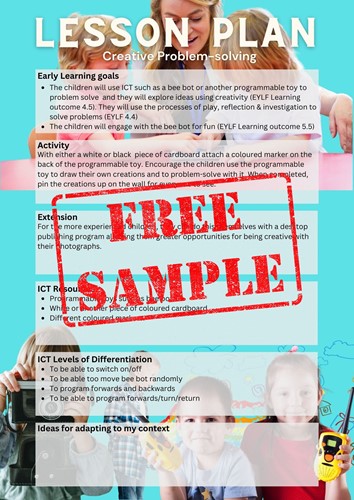By Michael Hilkemeijer
When Mia, a preschool teacher, first began looking for concept development activities for preschoolers, she found herself overwhelmed with ideas scattered across websites and forums. While she had some success integrating simple ICT lessons into her classroom, she often felt that something was missing—there was no structured way to teach ICT concepts in a meaningful and progressive manner.
One day, Mia stumbled upon the ICT in Education Teacher Academy. Intrigued by the promise of professional development that was both structured and adaptable, she decided to become a member. What Mia found was more than just a collection of lesson plans—it was a comprehensive approach to teaching ICT concepts to preschoolers. The academy’s resources not only provided practical activities but also empowered her to set her own learning agenda, allowing her professional growth while applying what she learned directly in her teaching environment.

How to Teach Drawing to Preschoolers with ICT
At one point, Mia needed to learn how to use a drawing and painting program that was available on her classroom computers, but she hadn’t fully exploited it yet. After accessing the ICT in Education Teacher Academy, she found a direct link to videos in the members' library on how to draw using Microsoft Paint 3D. Learning new ICT skills on a 'need to know' basis made her feel more confident, as the membership’s objectives were to ensure that she could:
-
Apply basic tools of a graphics editor to create her own drawings and paintings
-
Use the mouse to draw simple pictures
-
Customize the environment of the graphics editor
-
Recognize the most common formats
As Mia explored the activities related to drawing and painting, she appreciated how the membership exploited the fact that most ECE teachers, like herself, enjoy drawing and can naturally integrate it into their teaching. Through hands-on experience and discussing new ICT concepts, techniques, and tools, Mia learned about basic tools, images and files, selection and copy-paste, working with stamps, and more. The workbook’s structure helped her maintain direction and purpose, allowing her to confidently download and implement concept development activities for preschoolers. Soon, Mia started creating and sharing ideas for similar activities in the community.

Concept Development Activities for Preschoolers in the Membership
Mia’s experience of exploring creative activities through the membership revealed a wealth of engaging, hands-on experiences that truly support ICT concept development. Each activity connected to her teaching goals, and the workbook provided guided instructions on how to implement them effectively. What Mia appreciated most was not just accessing done-for-you activities, but also the ongoing support from the community, allowing her to seek advice and share reflections with fellow educators.
Creative Drawing and Colouring Activities
-
Colouring in Blank Images (EYLF 5.5): Children access blank images from the internet and use drawing and painting programs to color them in. This activity encourages experimentation with digital tools while enhancing fine motor skills and creativity【63†source】.
-
Best Way to Implement: Use the membership workbook to plan the activity, focusing on incorporating ICT techniques. Seek advice from the community on how to make the activity engaging and reflective of children's learning needs.
-
-
Drawing with Programmable Toys (EYLF 4.5, EYLF 5.5): Children use programmable toys like Bee Bots to create unique drawings by attaching markers to the toy. This hands-on activity integrates problem-solving with creative expression【70†source】.
-
Best Way to Implement: Follow the workbook prompts to reflect on how to introduce programming concepts. Share your implementation ideas with the community to gain feedback and suggestions.
-
-
Modelling Drawing Repeat Patterns (EYLF 4.5, EYLF 5.5): Children use drawing apps to create repeat patterns, developing an understanding of design and spatial awareness【84†source】.
-
Best Way to Implement: Plan the session using the workbook to map out steps and expected outcomes. Use the Wisdom Tool to explore different pattern-making strategies shared by other members.
-
-
Painting Over a Digital Photo (EYLF 4.5, EYLF 5.5): Children take photos of objects, upload them, and use drawing programs to paint over them. This activity combines photography with digital creativity【85†source】.
-
Best Way to Implement: Use the workbook to identify the skills children will practice. Connect with other members to discuss how to integrate storytelling elements into the painting process.
-
-
Creative Play - Drawing and Colouring (EYLF 4.5, EYLF 5.5): Children watch a video clip (e.g., of dinosaurs) and then draw their favorite one, using a drawing and painting program to enhance the image【67†source】.
-
Best Way to Implement: Use the membership's lesson plan templates to structure the activity. Post your ideas in the community to get feedback and tips on making the experience more interactive.
-
Creative Movement and Storytelling Activities
-
Bee Bot Dancing (EYLF 4.5, EYLF 5.5): Children create dance routines for Bee Bots, encouraging them to think critically about sequences and movements. Reviewing and refining their dance routines fosters problem-solving and digital engagement【64†source】.
-
Best Way to Implement: Follow workbook guidance to set clear learning intentions. Use the community to discuss ways to link coding and creative movement.
-
-
Abstract Art with Bee Bot (EYLF 4.5, EYLF 5.5): Children attach markers to a Bee Bot and move it around to create abstract artwork. The activity blends creativity with coding concepts【88†source】.
-
Best Way to Implement: Reflect on how to encourage collaboration during the activity using workbook prompts. Share your setup ideas with members for constructive feedback.
-
-
Speech Bubbles for Storytelling (EYLF 5.5): Children add speech bubbles to their photographs, allowing them to express ideas and practice digital storytelling skills. This helps them connect visual representation with language development【71†source】.
-
Best Way to Implement: Plan storytelling sessions using the workbook. Discuss in the community how to make storytelling accessible for children with diverse language abilities.
-
-
Playing with Walkie-Talkies (EYLF 5.3, EYLF 5.5): Children use walkie-talkies in role-play, enhancing communication skills and creative thinking【86†source】.
-
Best Way to Implement: Engage the community to explore how to integrate walkie-talkie play into group activities. Use workbook questions to prompt reflection on communication skills.
-
Why is understanding concepts important in early childhood education?
Concepts are fundamental building blocks in early childhood education. They help children understand direction, location, position, number, quantity, sequence, attributes, dimensions, size, and similarities and differences. Integrating digital technology in early childhood education, whether through play-based learning or intentional practices, requires a solid foundation in concept development.
By explicitly teaching ICT concepts, educators ensure that children can transfer their learning to new situations. For example, understanding basic computer terminology (like keyboard, mouse, and screen) helps children follow instructions and communicate effectively. This conceptual understanding also supports children in reflecting on their own and others’ technology use, fostering their ability to generalize concepts and make decisions.

The Path Forward: Integrating Technology and Teaching Concepts with Confidence
Mia’s story highlights that the key to teaching ICT concepts lies in structured professional support, practical lesson plans, and continuous learning. The ICT in Education Teacher Academy offers educators the tools they need to teach concepts in a way that enhances both their own professional growth and children’s learning.
How will you transform your approach to teaching concepts in preschool? Become a member today and access the resources that will make a difference.

